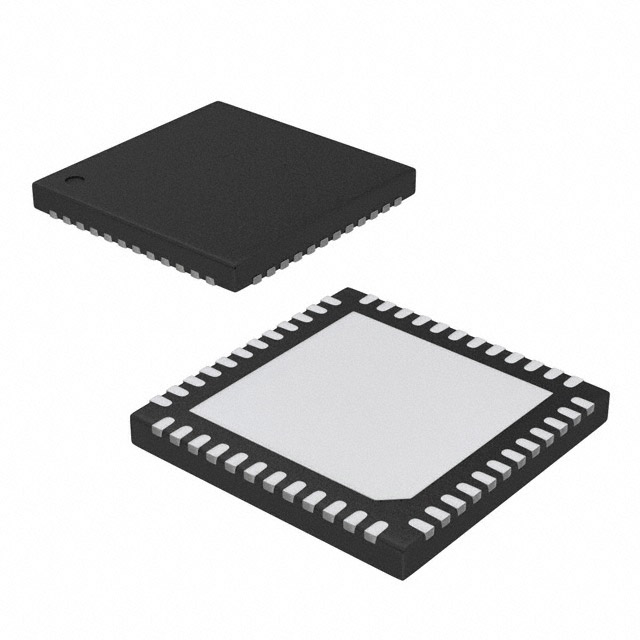ADCLK854BCPZ
Overview
Category
ADCLK854BCPZ belongs to the category of integrated circuits (ICs).
Use
ADCLK854BCPZ is commonly used in electronic devices for generating high-frequency clock signals.
Characteristics
- High precision and stability
- Wide frequency range
- Low power consumption
- Compact package size
Package
ADCLK854BCPZ is available in a small form factor package, typically a 32-pin LFCSP (Lead Frame Chip Scale Package).
Essence
The essence of ADCLK854BCPZ lies in its ability to generate accurate and reliable clock signals for various applications.
Packaging/Quantity
ADCLK854BCPZ is usually packaged in reels or trays, with a typical quantity of 250 units per reel/tray.
Specifications and Parameters
- Frequency Range: 1 MHz to 2.5 GHz
- Supply Voltage: 3.3 V
- Output Type: LVPECL, LVDS, CML
- Operating Temperature Range: -40°C to +85°C
- Power Consumption: 150 mW (typical)
Pin Configuration
For a detailed and complete pin configuration diagram of ADCLK854BCPZ, please refer to the manufacturer's datasheet.
Functional Characteristics
ADCLK854BCPZ offers the following functional characteristics:
- Multiple output channels
- Programmable frequency divider
- Phase-locked loop (PLL) for frequency synthesis
- Adjustable output amplitude
- Low jitter performance
Advantages and Disadvantages
Advantages
- High precision and stability
- Wide frequency range
- Low power consumption
- Compact package size
- Multiple output options
Disadvantages
- Limited operating temperature range (-40°C to +85°C)
- Requires external components for optimal performance
Applicable Range of Products
ADCLK854BCPZ is suitable for a wide range of applications, including:
- Telecommunications equipment
- Data communication devices
- Test and measurement instruments
- Radar systems
- High-speed data converters
Working Principles
ADCLK854BCPZ operates based on the principle of frequency synthesis using a PLL. It takes an input reference clock and generates multiple output clocks with programmable frequencies and adjustable amplitudes.
Detailed Application Field Plans
ADCLK854BCPZ can be used in various applications, such as:
- Wireless Communication Systems: Provides accurate clock signals for wireless transceivers, ensuring reliable data transmission.
- High-Speed Data Converters: Synchronizes the sampling rate of analog-to-digital converters (ADCs) and digital-to-analog converters (DACs), improving overall system performance.
- Radar Systems: Generates precise timing signals for radar systems, enabling accurate target detection and tracking.
- Test and Measurement Instruments: Provides stable clock signals for precise timing measurements in oscilloscopes, spectrum analyzers, and other test equipment.
- Networking Equipment: Ensures synchronized data transfer in routers, switches, and other network devices, enhancing network performance.
Detailed Alternative Models
Some alternative models to ADCLK854BCPZ include:
- AD9528
- MAX038
- CDCE62005
5 Common Technical Questions and Answers
Q: What is the maximum frequency range supported by ADCLK854BCPZ? A: ADCLK854BCPZ supports a frequency range from 1 MHz to 2.5 GHz.
Q: Can ADCLK854BCPZ operate with a supply voltage other than 3.3 V? A: No, ADCLK854BCPZ requires a supply voltage of 3.3 V for proper operation.
Q: What are the available output types of ADCLK854BCPZ? A: ADCLK854BCPZ supports LVPECL, LVDS, and CML output types.
Q: What is the typical power consumption of ADCLK854BCPZ? A: ADCLK854BCPZ has a typical power consumption of 150 mW.
Q: Can ADCLK854BCPZ operate in extreme temperature conditions? A: No, ADCLK854BCPZ has an operating temperature range of -40°C to +85°C.
This encyclopedia entry provides an overview of ADCLK854BCPZ, including its category, use, characteristics, package, essence, packaging/quantity, specifications and parameters, pin configuration, functional characteristics, advantages and disadvantages, applicable range of products, working principles, detailed application field plans, alternative models, and common technical questions and answers.


